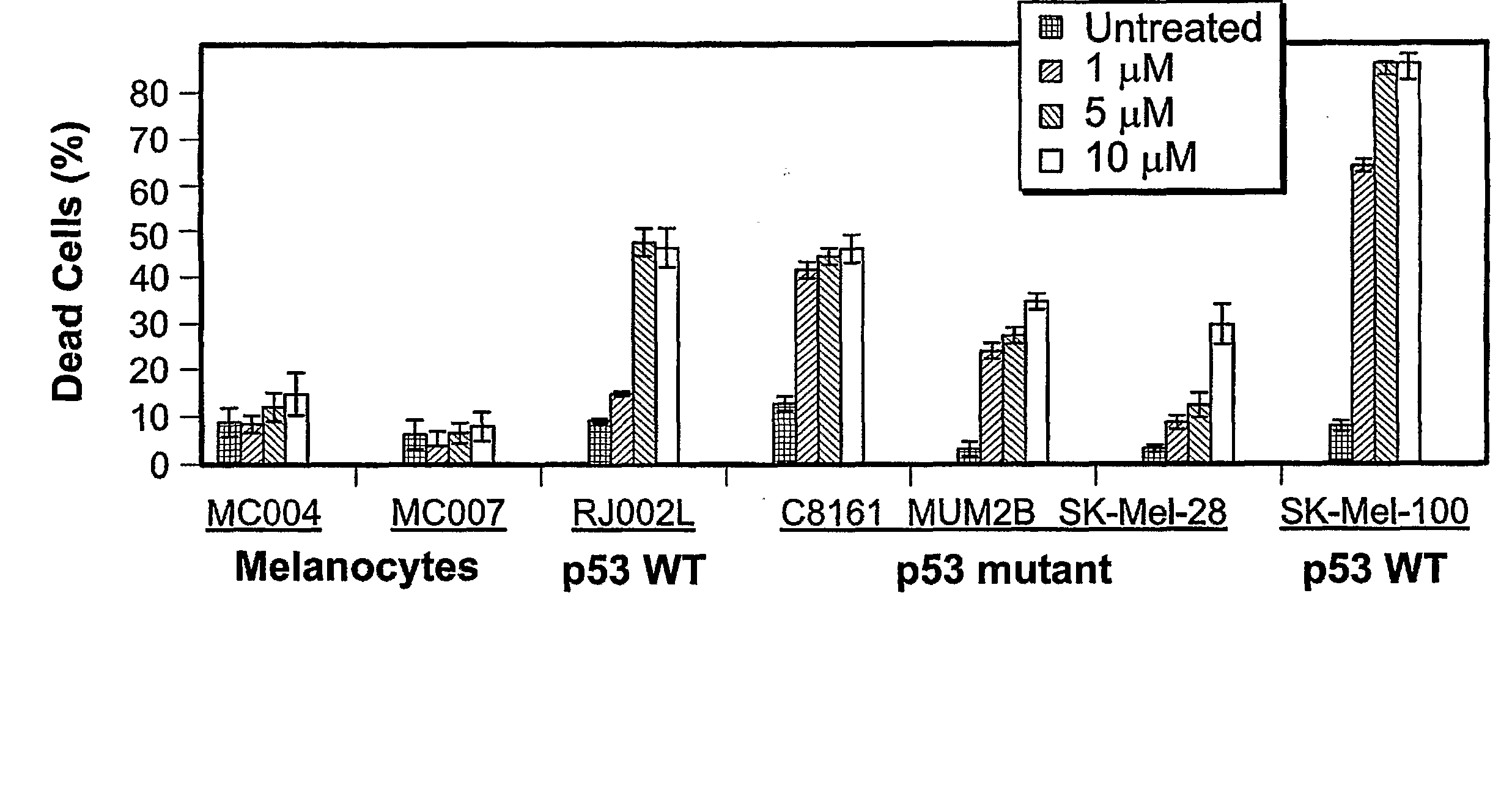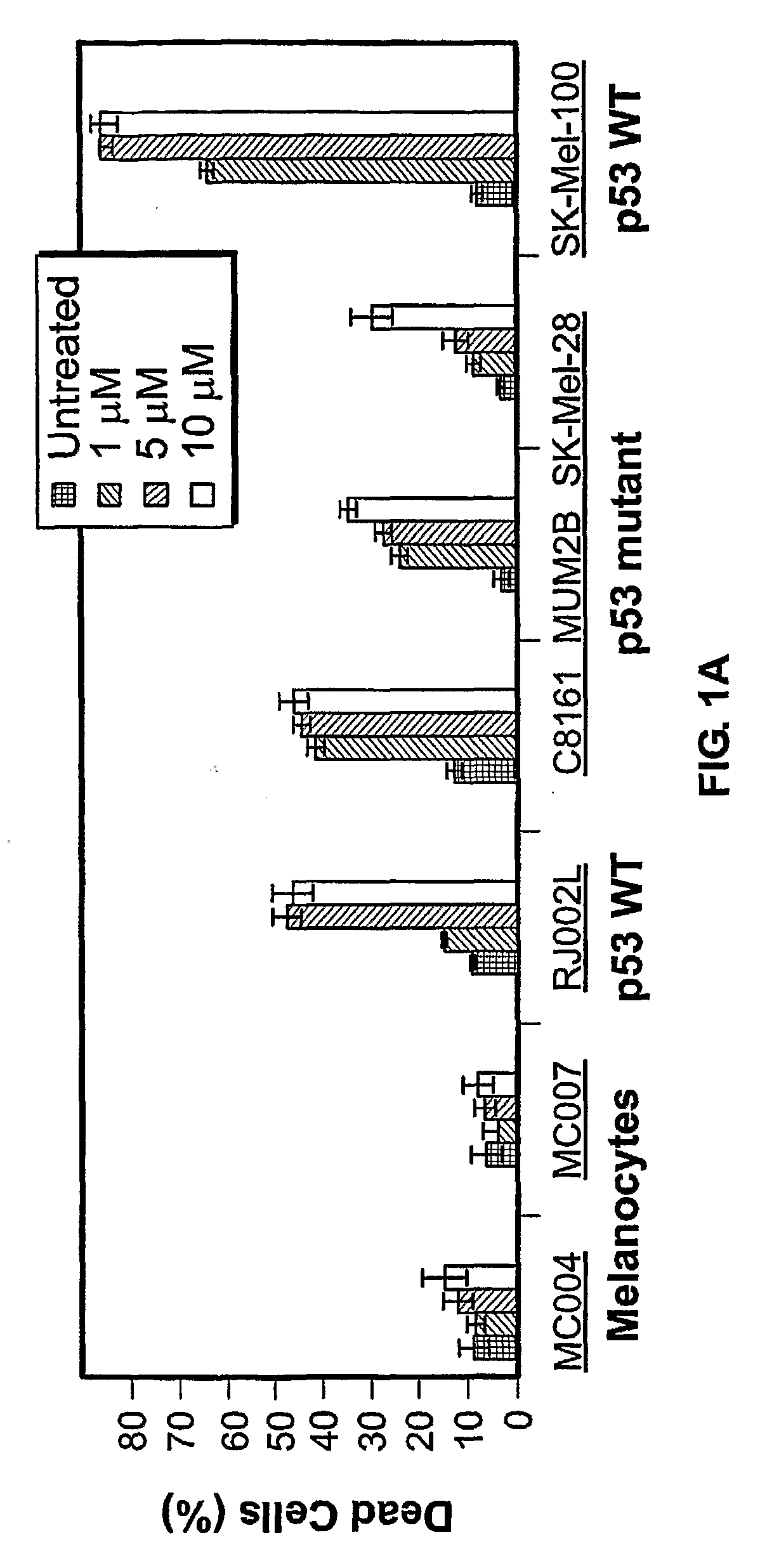Compositions for Inhibiting Cell Growth and Inducing Apoptosis in Cancer Cells and Methods of Use Thereof
a technology of cell growth and induction of apoptosis, which is applied in the direction of drug compositions, biochemistry apparatus and processes, peptides/protein ingredients, etc., can solve the problems of reducing the usefulness of drugs, traditional methods of treatment are not successful in treating many types of cancer, and individual drugs used alone are often ineffective in treating cancer
- Summary
- Abstract
- Description
- Claims
- Application Information
AI Technical Summary
Benefits of technology
Problems solved by technology
Method used
Image
Examples
example 1
Effect of z-Leu-Leu-Nle-CHO on Melanoma Cells and Normal Human Melanocytes In Vitro
[0222] The effect of z-Leu-Leu-Nle-CHO on apoptosis was tested in vitro using normal human melanocytes and several melanoma cell cultures. Prior to testing, cutaneous (C8161, SK-MeI-28, SK-MeI-100, SK-MeI-5, C81-61), uveal or ocular (MUM2B, MUM2C, OCM-1A), and pulmonary metastases (RJ002L) melanoma cell lines were maintained in RPMI supplemented with 10% FBS. Normal human melanocytes were isolated from neonatal foreskins as previously described (Qin J et al., 2004, Mol Cancer Ther 3:895-902) and cultured with medium 154 containing growth supplements (Cascade Biologics, Portland, Oreg.).
[0223] The p53 gene of the melanoma cell lines was characterized. First, DNA was isolated from each cell line using standard methods. Then, each exon of the p53 gene was amplified using PCR, and the PCR products were purified using solid phase reversible immobilization (SPR1)-based technology (AMPURE; Agencourt Biosci...
example 2
Effect of z-Leu-Leu-Nle-CHO on Melanoma Cells In Vivo
[0228] Assessment of tumor formation in Nude mice was performed by adapting the method described in Hendrix, M. J. et al., 1997, Am J Pathol 150:483-495. Tumors were established in Nude mice as follows. Briefly, 1×106 aggressive melanoma cells (C8161) (ATCC, Rockville, Md.) were injected subcutaneously in Nude mice on day 0, and the tumors were allowed to grow for 1 week. Beginning on day 8, mice received injections (100 μl) of DMSO carrier only (control group) or z-Leu-Leu-Nle-CHO (1 mM in DMSO) (Calbiochem, LaJolla, Calif.) (experimental group) every other day for 1 week. Tumor sizes (mm2) were determined on day 7 prior to injections with or z-Leu-Leu-Nle-CHO or DMSO, and on day 14. Average tumor size for both groups was normalized, and size of tumors at 2 weeks was averaged. Detection of apoptosis in tissue sections was performed using TUNEL staining as described in Wrone-Smith et al, 1997, Am J Pathol. 151:1321-9.
[0229]FIGS....
example 3
Effectiveness of z-Leu-Leu-Nle-CHO Versus Chemotherapeutic Agents on Killing Melanoma Cells In Vitro
[0230] An initial dosing study comparing z-Leu-Leu-Nle-CHO against three different chemotherapeutic agents (i.e., adriamycin, etoposide, and cisplatin) was performed to evaluate the relative effectiveness of z-Leu-Leu-Nle-CHO in killing melanoma cells. In agreement with a previous report by Soengas, M. S. et al., 2001, Nature 409.207-211, SK-MeI-28 cells, carrying a mutated p53, were relatively resistant to killing by adriamycin, as well as to killing by other chemotherapeutic agents. For SK-MeI-28 melanoma cells, the maximal apoptotic response for adriamycin, etoposide, cisplatin, and z-Leu-Leu-Nle-CHO was 12.0%, 2.6%, 4.0%, and 29.4%, respectively. For RJ002L melanoma cells, the maximal apoptotic response for adriamycin, etoposide, cisplatin, and z-Leu-Leu-Nle-CHO was 23.9%, 12.7%, 3.4%, and 45.7%, respectively. Thus, z-Leu-Leu-Nle-CHO was more effective in killing both SK-MeI-28 a...
PUM
 Login to View More
Login to View More Abstract
Description
Claims
Application Information
 Login to View More
Login to View More - R&D
- Intellectual Property
- Life Sciences
- Materials
- Tech Scout
- Unparalleled Data Quality
- Higher Quality Content
- 60% Fewer Hallucinations
Browse by: Latest US Patents, China's latest patents, Technical Efficacy Thesaurus, Application Domain, Technology Topic, Popular Technical Reports.
© 2025 PatSnap. All rights reserved.Legal|Privacy policy|Modern Slavery Act Transparency Statement|Sitemap|About US| Contact US: help@patsnap.com



